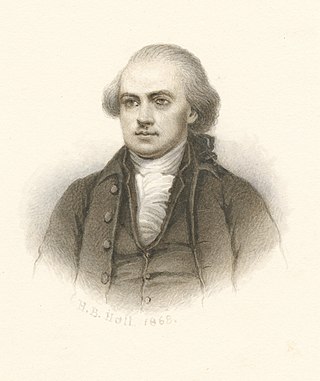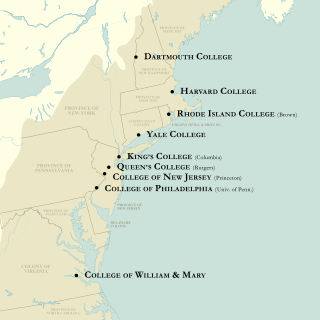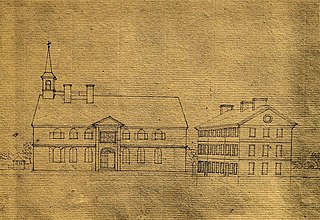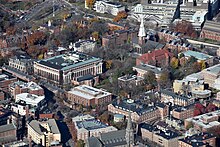
The Ivy League is an American collegiate athletic conference, comprising eight private research universities in the Northeastern United States. The term Ivy League is typically used outside sports to refer to the eight schools as a group of elite colleges with connotations of academic excellence, selectivity in admissions, and social elitism. Its members are Brown University, Columbia University, Cornell University, Dartmouth College, Harvard University, Princeton University, University of Pennsylvania, and Yale University. The conference headquarters are in Princeton, New Jersey.

Pennsylvania, officially the Commonwealth of Pennsylvania, is a state spanning the Mid-Atlantic, Northeastern, Appalachian, and Great Lakes regions of the United States. Pennsylvania borders Delaware to its southeast, Maryland to its south, West Virginia to its southwest, Ohio and the Ohio River to its west, Lake Erie and New York to its north, the Delaware River and New Jersey to its east, and the Canadian province of Ontario to its northwest.

The University of Pennsylvania is a private Ivy League research university in Philadelphia, Pennsylvania, U.S. It is one of nine colonial colleges and was chartered prior to the U.S. Declaration of Independence when Benjamin Franklin, the university's founder and first president, advocated for an educational institution that trained leaders in academia, commerce, and public service. Penn identifies as the fourth oldest institution of higher education in the United States, though this representation is challenged by other universities, as Franklin first convened the board of trustees in 1749, arguably making it the fifth oldest institution of higher education in the U.S.

A royal charter is a formal grant issued by a monarch under royal prerogative as letters patent. Historically, they have been used to promulgate public laws, the most famous example being the English Magna Carta of 1215, but since the 14th century have only been used in place of private acts to grant a right or power to an individual or a body corporate. They were, and are still, used to establish significant organisations such as boroughs, universities and learned societies.
The University of Pennsylvania Carey Law School is the law school of the University of Pennsylvania, a private Ivy League research university in Philadelphia, Pennsylvania. Penn Carey Law offers the degrees of Juris Doctor (J.D.), Master of Laws (LL.M.), Master of Comparative Laws (LL.C.M.), Master in Law (M.L.), and Doctor of the Science of Law (S.J.D.).
This section of the timeline of United States history concerns events from before the lead up to the American Revolution.

William Ellery was a Founding Father of the United States, one of the 56 signers of the United States Declaration of Independence, and a signer of the Articles of Confederation as a representative of Rhode Island.

The Province of Pennsylvania, also known as the Pennsylvania Colony, was a British North American colony founded by William Penn, who received the land through a grant from Charles II of England in 1681. The name Pennsylvania was derived from "Penn's Woods", referring to William's father Admiral Sir William Penn.

The Massachusetts Supreme Judicial Court (SJC) is the highest court in the Commonwealth of Massachusetts. Although the claim is disputed by the Supreme Court of Pennsylvania, the SJC claims the distinction of being the oldest continuously functioning appellate court in the Americas, with a recognized history dating to the establishment of the Massachusetts Superior Court of Judicature in 1692 under the charter of the Province of Massachusetts Bay.

The colonial colleges are nine institutions of higher education chartered in the Thirteen Colonies before the founding of the United States of America during the American Revolution. These nine have long been considered together, notably since the survey of their origins in the 1907 The Cambridge History of English and American Literature.

The Academy and College of Philadelphia (1749-1791) was a boys' school and men's college in Philadelphia in the colonial-era Province of Pennsylvania.

Amy Gutmann is an American academic and diplomat who has served as the United States Ambassador to Germany since 2022. She was previously the president of the University of Pennsylvania from 2004 to 2022, the longest-serving president in the history of the University of Pennsylvania.

William Penn Charter School is an independent school in Philadelphia, Pennsylvania. It was founded in 1689 at the urging of William Penn as the "Public Grammar School" and chartered in 1689 to be operated by the "Overseers of the public School, founded by Charter in the town and county of Philadelphia" in Pennsylvania. It is the oldest Quaker school in the world, the oldest elementary school in Pennsylvania, and the fifth oldest elementary school in the United States following The Collegiate School, Boston Latin School (1635), Hartford Public High School (1638), and Roxbury Latin (1645).
The following is a timeline of women's colleges in the United States. These are institutions of higher education in the United States whose student population comprises exclusively, or almost exclusively, women. They are often liberal arts colleges. There are approximately 35 active women's colleges in the U.S. as of 2021.
The title of oldest public university in the United States is claimed by three universities: the University of Georgia, the University of North Carolina at Chapel Hill, and the College of William and Mary. Each has a distinct basis for the claim: North Carolina being the first to hold classes and graduate students as a public institution, Georgia being the first created by state charter, and William & Mary having the oldest founding and operations dates of any current public university, but it was a private institution for over 200 years, until 1906. While all three universities closed for a time as a result of the American Civil War, William and Mary was closed for over two decades.

James Wilson was a Scottish-born American Founding Father, legal scholar, jurist, and statesman who served as an associate justice of the United States Supreme Court from 1789 to 1798. Wilson was elected twice to the Continental Congress, was a signatory of the Declaration of Independence, and was a major participant in drafting the U.S. Constitution becoming one of only six people to sign both documents. A leading legal theorist, he was one of the first four Associate Justices appointed to the Supreme Court by George Washington. In his capacity as the first professor of law at the College of Philadelphia, he taught the first course on the new Constitution to President Washington and his Cabinet in 1789 and 1790.
The University of Pennsylvania College of Arts & Sciences (CAS) is the oldest undergraduate college at the University of Pennsylvania, a private Ivy League university, situated on the university's main campus in University City, Philadelphia. The college traces its roots to the establishment of a secondary school known as Unnamed Charity School in 1740. In 1749, Benjamin Franklin and twenty-one leading citizens of Philadelphia officially founded a secondary school named Academy of Philadelphia. In 1755, the secondary school was expanded to include a collegiate division known as College of Philadelphia. The secondary and collegiate institutions were known collectively as The academy and College of Philadelphia. The college received its charter from Thomas Penn and Richard Penn. Penn CAS is the oldest institution of higher learning in the state of Pennsylvania and the sixth-oldest chartered college in the United States.












